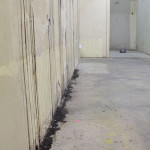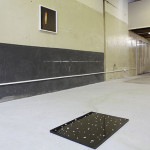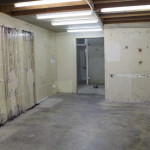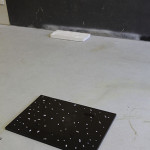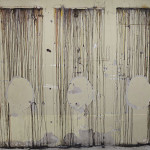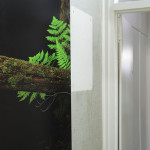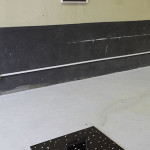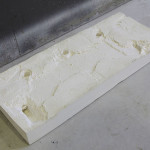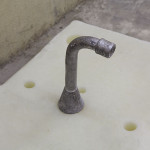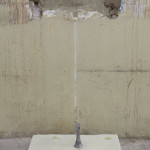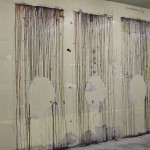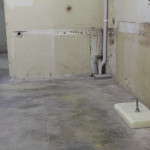Notes on materiality
1. Slug Oil (2013): Lead slugs cast from molds made from the plug holes in the walls at Outward. Slugs imbedded in pigmented epoxy resin. Slug Oil occupies the central floor area at Outward that was re-concreted. It reflects the ceiling and the walls, but it also reflects Polaroid for (R.B) as though it is immersed in oil; how would R.B read the evasiveness of the photographic image in oil? The ‘black oil’ metaphorically runs down the walls of Stain in three parts. In may flow from the spout of Spout and Vessel (a leaky one). [Also see Slug text from Lilt]
2. Polaroid for (R.B) (2010-2013): The signifiers of the Polaroid photograph removed—contextual size, white frame of particular proportions—to open the potential of a rudimentary analogue technology into the digital realm. This transposition draws attention to the technical limitations of the Polaroid yet enhances its evocative and subtractive potential (less detail and information that is counter to the obsession with clarity and sharpness; faith that the photograph is closest to the referent through the most advanced ‘capturing’ technology). The intent was to imagine an image based on words and then to make that image guided by this language: the text that is turned into image.
3. Stain in three parts (2013): The stains accumulate over many years running behind the industrial sink in a workshop: the citation referred to as Inside-out. Stain in three parts is located in the rear, lower ceiling section of Outward, opposite Spout and Vessel (which sits below the deferred referent of Inside-out). The spout of Spout and Vessel points towards the central stain of Stain in three parts. The stains run from three horizontal fixtures since removed to run around three oval bathroom fixtures since removed. The stains being a range of substances from art pigments, ink and acrylic art mediums to shellac, Prepsol, and melted surf board wax mix and react as they chase down the wall to form pools on the floor.
4. Yield (2010-13): Upon entering Outward with a glance to the very rear a silver grey object sits in an open doorway that leads to another door into a bathroom. This small space in between the rear gallery space and the bathroom is where the lead object rests. The object even upon close inspection is indeterminate in its signification. Yet it is the close inspection of this object that reveals its partner image on the wall of the alcove—a view directly down a disused goldmine. This photograph confronts the viewer in the small space between bathroom and gallery, the openings and textures simultaneously confine and release. [Also see Yield fragment]
5. Spout and Vessel (2013): An industrial indeterminate object cast in modelling wax sits on the floor below the traces of a former plumbing fixture—referring to Inside-out. The cast lead spout stands atop pointing towards Stain in three parts. The first version of Duchamp’s Objet Dard (1951) was in plaster with a lead strip inserted into the length of it. The subsequent edition was in bronze with a painted lead strip. The vessel is the fragment of the whole that can never be complete. It is a reconstruction and rematerialisation in the false image of something that has been. Wax is a vicarious substance, especially its role in lost wax casting.
6. Inside-out (2012-13): The first text for this project was the mold made from a section of wall where a plumbing fixture was formerly mounted (above Spout and Vessel). From this area of wall the web emanated, not as a centre but as a moment of diffusion and release. The photograph of this section of wall is placed at the same height but located in the front area of Outward. It points to its Other in the rear of the space. Offset lying on the floor below is a casting of this section of wall. The thickness of the Hydrostone plaster makes it an object to which the other displaced referents cannot but form tenuous connections. This shift—to the side, down the gallery, in another material, in a photograph—all highlight the problem of the referent, the mold, the casting, the photograph, the text as textual displacements; inside-out.
notes on the index publication

